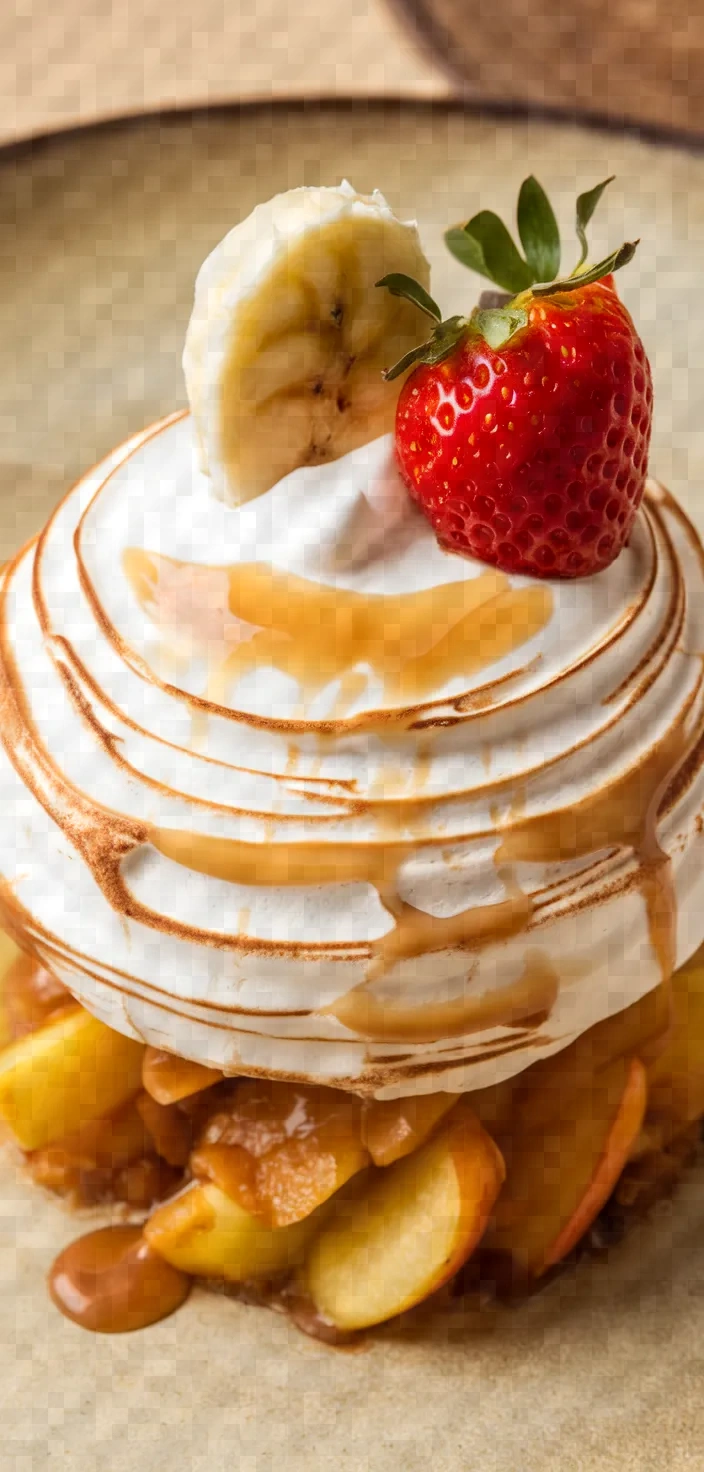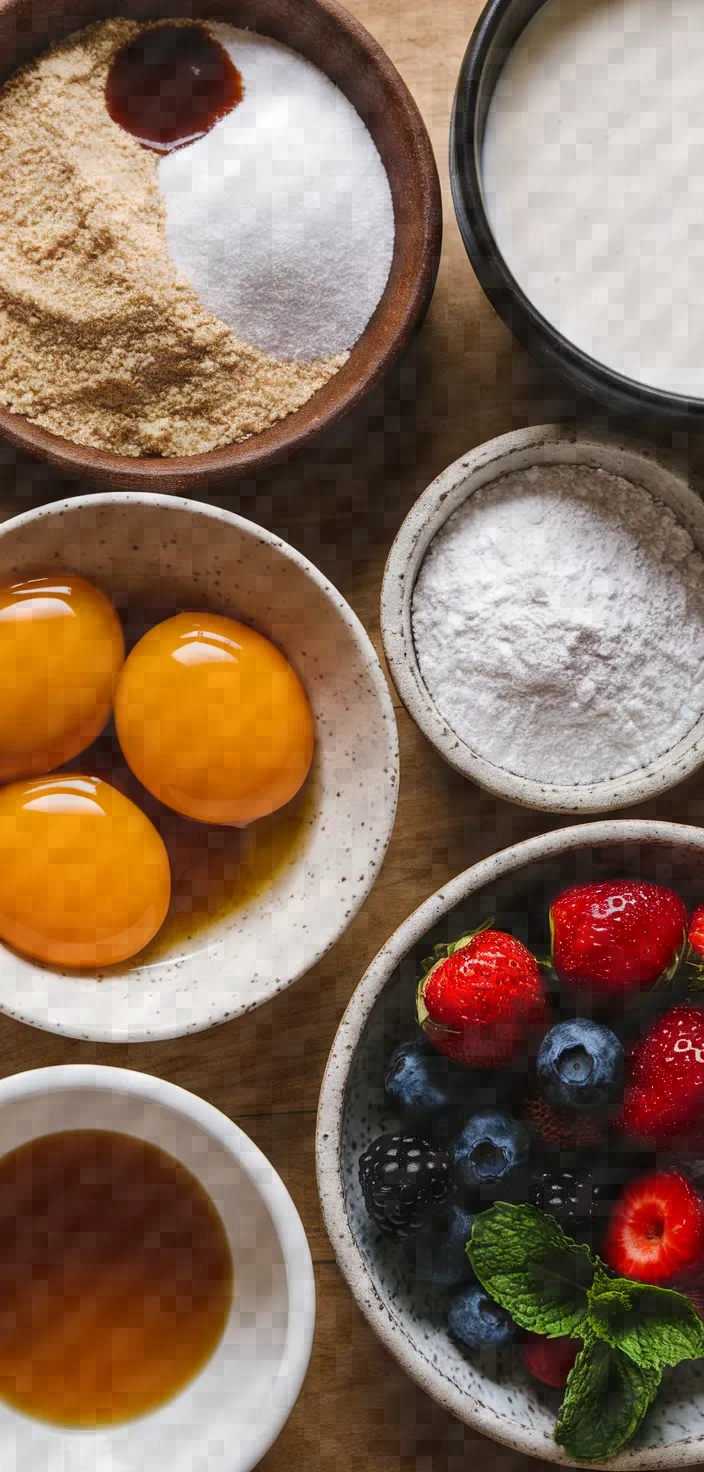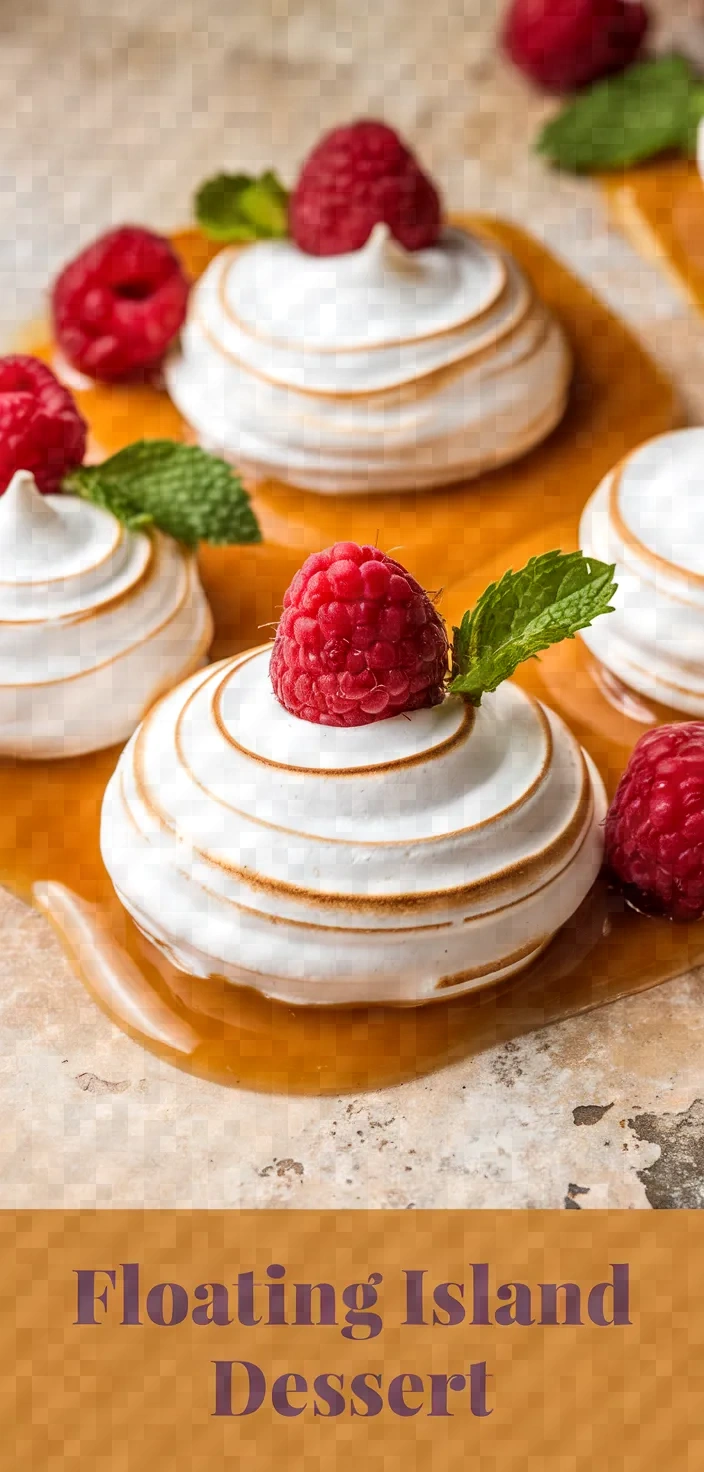I just whipped up a batch of dreamy floating islands, and let me tell you, this dessert is like an elegant dance-off between silky meringue peaks and the smooth, vanilla-kissed crème anglaise. Garnished with a sprinkle of powdered sugar and a playful drizzle of caramel, it’s the perfect treat for when you’re feeling extra but still want to keep things chill and fancy.

My favorite dessert of all time is Floating Island, which features delicate meringue floating above creamy custard. The recipe balances 4 large eggs with whole milk, a rich source of protein and calcium.
The optional drizzle of caramel sauce puts it over the top. Even without caramel, though, this dessert has a delightful combination of textures and flavors: the melt-in-your-mouth meringue, the smooth custard, and the crunchy, glassy topping.
If you’re having a dinner party or just want to impress someone with your culinary skills, make this dish.
Floating Island Dessert Recipe Ingredients

- Eggs: High in protein, essential for fluffy meringue.
- Sugar: Provides sweetness, balances the dessert’s flavor.
- Vanilla Extract: Adds aromatic flavor, enhances overall taste.
- Cream of Tartar: Stabilizes egg whites for stable meringue peaks.
- Whole Milk: Provides creaminess, base for custard.
- Vanilla Bean: Adds authentic vanilla flavor, elevates dessert’s aroma.
Floating Island Dessert Recipe Ingredient Quantities
- 4 large eggs, separated
- 1/2 cup granulated sugar, divided
- 1 teaspoon vanilla extract
- 1/4 teaspoon cream of tartar
- 2 cups whole milk
- 1/2 vanilla bean, split and seeds scraped
- 2 tablespoons powdered sugar
- Caramel sauce, for drizzling (optional)
- Fresh berries or mint leaves, for garnish (optional)
How to Make this Floating Island Dessert Recipe
1. Start with the meringue. In a mixing bowl that’s as clean as a whistle, whip the egg whites with the cream of tartar until they’re more than just foamy—they should be at the stage where they’re almost starting to hold some shape. Then, with the mixer going, very gradually add in a quarter cup of granulated sugar that’s been sitting at a 1:1 ratio with the eggs for some time (in other words, it’s at room temperature and very ready to serve). Keep beating until what you’ve got are egg whites that have gone way beyond the ruffled look and now are standing on not just one but several sturdy corners as peaks that are also shiny in a way that suggests you maybe should have gone for the clear vanilla. And you should have.
2. In another saucepan, warm the milk with the vanilla bean seeds and pod over medium heat until it reaches a gentle simmer. Take it off the heat.
3. Using two large spoons, shape the meringue into oval-shaped quenelles and gently float them in the milk that is at a simmer. Each side should be poached for 2-3 minutes until it is puffed and cooked through. Remove with a slotted spoon and set aside on a plate.
4. Whisk the egg yolks with the remaining 1/4 cup of granulated sugar and vanilla extract until pale and thickened to prepare the crème anglaise.
5. Pour the hot milk into the egg yolk mixture very slowly, whisking all the while to keep the eggs from cooking too quickly. Then, return the mixture to the pan.
6. Heat slowly over low heat, and in almost any situation those instructions mean to take the time required for whatever is being heated to reach the same low temperature throughout, without any part of it getting too hot and cooking the ingredients unevenly. For custards, that means reaching a temperature of about 180° F. at which the eggs will thicken the mixture enough so that it will pass the back of the spoon test.
7. Pour the crème anglaise through a fine-mesh sieve into a clean bowl to separate it from any solidified egg parts and the vanilla pod. Allow it to rest until it reaches room temperature.
8. Transfer the cooled crème anglaise into shallow serving bowls or dishes.
9. Put the meringue islands on the custard in each bowl.
10. Dust with confectioner’s sugar, drizzle with sauce de caramel (if using), and garnish with fresh berries or mint leaves before serving.
Floating Island Dessert Recipe Equipment Needed
1. Mixing bowl
2. Hand or stand mixer
3. Measuring cups
4. Measuring spoons
5. Saucepan
6. Large spoons
7. Slotted spoon
8. Whisk
9. Fine-mesh sieve
10. Clean bowl
11. Instant-read thermometer (optional, for checking temperature)
12. Plates
13. Shallow serving bowls or dishes
FAQ
- What is Floating Island Dessert?“îles flottantes” (the plural for Floating Island) is a classic dessert of French cuisine. To make it, one poaches meringue in two or three parts—an extremely delicate operation—and serves it up on a creamy, feather-light vanilla “sauce,” which is not a custard, even though the arrangement looks very much like the meringues are floating on little islands of vanilla custard. We seem to be in the habit at Atlas Obscura of telling you about the meringue elements of a dish, and then following up with very precise directions for making a very undelicate French dessert. So joke’s on us.
- Can I prepare this dessert in advance?Certainly! The base of the custard and the poached meringues can be made several hours ahead of time. Keep the meringues on a baking sheet with parchment paper in the fridge; the custard should stay nice and cool, too, until serving. Just before you bring this to the table, assemble the two and beat the egg white. You’ll need the beaten egg white for a frothy, creamy topping.
- What can I use if I don’t have a vanilla bean?In case you don’t have a vanilla bean on hand, 1 teaspoon of pure vanilla extract may be used as a substitution. The extract will yield a flavor profile that is similar to that of the bean.
- How do I know when the meringues are poached perfectly?When they hold their shape and are firm to the touch, the meringues are finished, taking usually about 3-5 minutes per side.
- What if I don’t have cream of tartar?If you don’t have cream of tartar, substitute with an equal amount of lemon juice or white vinegar to stabilize the egg whites.
- Can I make this dessert dairy-free?You can indeed replace the whole milk with a dairy-free alternative, such as almond or coconut milk; just be aware that this might tweak the flavor and texture a little.
Floating Island Dessert Recipe Substitutions and Variations
1/2 cup of divided granulated sugar.
Replace with 1/2 cup honey or 1/2 cup maple syrup. The flavor and texture may slightly differ from the original.
One teaspoon of vanilla extract.
Use 1 vanilla bean, split and seeds scraped, or use 1 teaspoon almond extract (this will give a different flavor profile).
1/4 teaspoon tartar sauce
1/2 teaspoon lemon juice or 1/4 teaspoon white vinegar (helps stabilize egg whites) can be used instead of.
2 cups of unskimmed milk
Replace with 2 cups of almond milk or 2 cups of coconut milk (different taste and texture).
Pro Tips
1. Meringue Precision Ensure all mixing bowls and utensils used for the meringue are thoroughly clean and free of any grease. Even the smallest amount of fat can prevent egg whites from whipping properly. You can wipe your tools with a little vinegar or lemon juice before starting to ensure they’re clean.
2. Room Temperature Eggs To achieve the best volume for your meringue, use eggs that are at room temperature. Cold egg whites take longer to whip and may not achieve the desired stiffness.
3. Slowly Incorporate Sugar When adding sugar to the egg whites, do so gradually. Adding the sugar too quickly can deflate the meringue and prevent it from reaching stiff peaks.
4. Even Poaching Heat Maintain a consistent low heat when poaching the meringue. If the milk is too hot, the meringue can dissolve or cook too quickly. Keep the milk at a gentle simmer to allow the meringue to cook evenly.
5. Straining the Crème Anglaise After thickening the crème anglaise, always strain it through a fine-mesh sieve. This step ensures a silky-smooth texture by removing any cooked egg bits or vanilla pod remnants, resulting in a flawless custard.

Floating Island Dessert Recipe
My favorite Floating Island Dessert Recipe
Equipment Needed:
1. Mixing bowl
2. Hand or stand mixer
3. Measuring cups
4. Measuring spoons
5. Saucepan
6. Large spoons
7. Slotted spoon
8. Whisk
9. Fine-mesh sieve
10. Clean bowl
11. Instant-read thermometer (optional, for checking temperature)
12. Plates
13. Shallow serving bowls or dishes
Ingredients:
- 4 large eggs, separated
- 1/2 cup granulated sugar, divided
- 1 teaspoon vanilla extract
- 1/4 teaspoon cream of tartar
- 2 cups whole milk
- 1/2 vanilla bean, split and seeds scraped
- 2 tablespoons powdered sugar
- Caramel sauce, for drizzling (optional)
- Fresh berries or mint leaves, for garnish (optional)
Instructions:
1. Start with the meringue. In a mixing bowl that’s as clean as a whistle, whip the egg whites with the cream of tartar until they’re more than just foamy—they should be at the stage where they’re almost starting to hold some shape. Then, with the mixer going, very gradually add in a quarter cup of granulated sugar that’s been sitting at a 1:1 ratio with the eggs for some time (in other words, it’s at room temperature and very ready to serve). Keep beating until what you’ve got are egg whites that have gone way beyond the ruffled look and now are standing on not just one but several sturdy corners as peaks that are also shiny in a way that suggests you maybe should have gone for the clear vanilla. And you should have.
2. In another saucepan, warm the milk with the vanilla bean seeds and pod over medium heat until it reaches a gentle simmer. Take it off the heat.
3. Using two large spoons, shape the meringue into oval-shaped quenelles and gently float them in the milk that is at a simmer. Each side should be poached for 2-3 minutes until it is puffed and cooked through. Remove with a slotted spoon and set aside on a plate.
4. Whisk the egg yolks with the remaining 1/4 cup of granulated sugar and vanilla extract until pale and thickened to prepare the crème anglaise.
5. Pour the hot milk into the egg yolk mixture very slowly, whisking all the while to keep the eggs from cooking too quickly. Then, return the mixture to the pan.
6. Heat slowly over low heat, and in almost any situation those instructions mean to take the time required for whatever is being heated to reach the same low temperature throughout, without any part of it getting too hot and cooking the ingredients unevenly. For custards, that means reaching a temperature of about 180° F. at which the eggs will thicken the mixture enough so that it will pass the back of the spoon test.
7. Pour the crème anglaise through a fine-mesh sieve into a clean bowl to separate it from any solidified egg parts and the vanilla pod. Allow it to rest until it reaches room temperature.
8. Transfer the cooled crème anglaise into shallow serving bowls or dishes.
9. Put the meringue islands on the custard in each bowl.
10. Dust with confectioner’s sugar, drizzle with sauce de caramel (if using), and garnish with fresh berries or mint leaves before serving.










